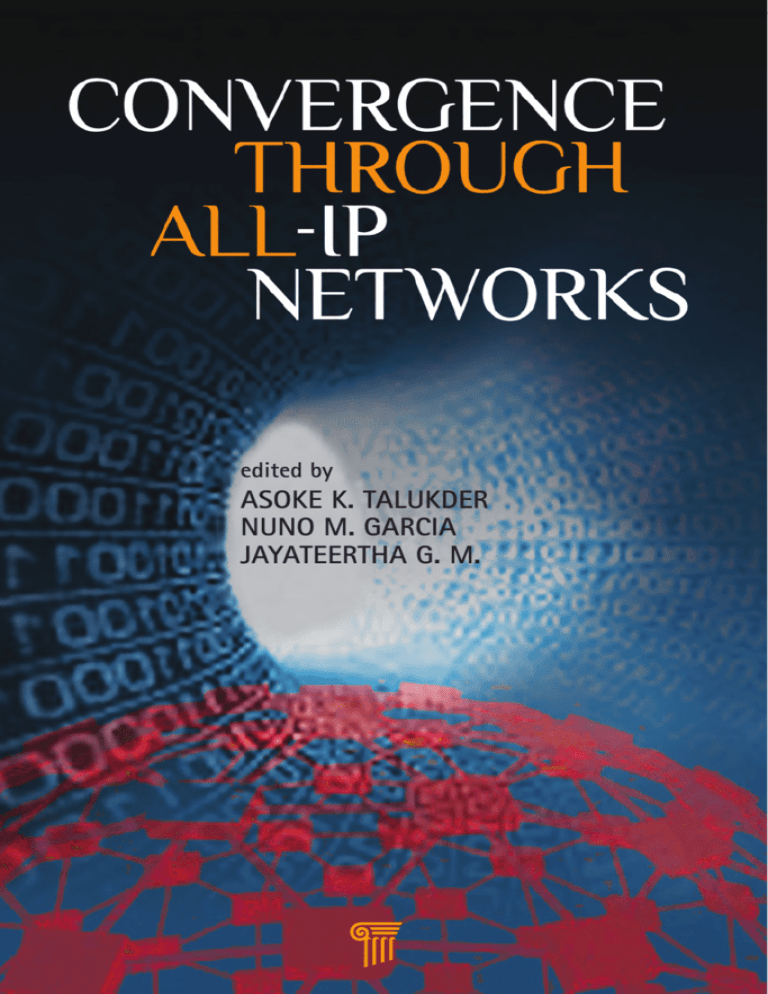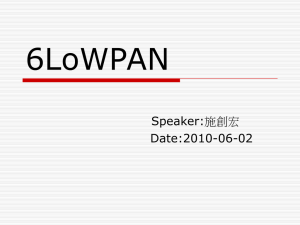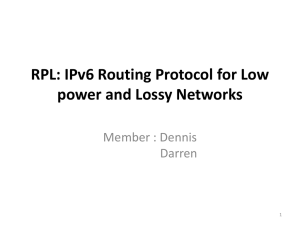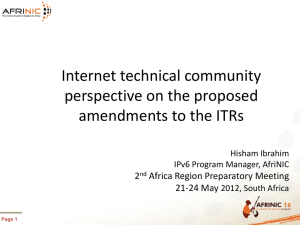
-
edited by
ASOKE K. TALUKDER
NUNO M. GARCIA
JAYATEERTHA G. M.
CONVERGENCE
THROUGH
ဗ
NETWORKS
CONVERGENCE
THROUGH
ဗ
NETWORKS
editors
edited by
Preben Maegaard
ASOKE K. TALUKDER
Anna Krenz
NUNO M. GARCIA
Wolfgang Palz
JAYATEERTHA G. M.
The Rise of Modern Wind Energy
Wind Power
for the World
Published by
Pan Stanford Publishing Pte. Ltd.
Penthouse Level, Suntec Tower 3
8 Temasek Boulevard
Singapore 038988
Email: editorial@panstanford.com
Web: www.panstanford.com
British Library Cataloguing-in-Publication Data
A catalogue record for this book is available from the British Library.
Convergence through All-IP Networks
Copyright © 2014 Pan Stanford Publishing Pte. Ltd.
All rights reserved. This book, or parts thereof, may not be reproduced
in any form or by any means, electronic or mechanical, including photocopying, recording or any information storage and retrieval system now
known or to be invented, without written permission from the publisher.
For photocopying of material in this volume, please pay a copying fee
through the Copyright Clearance Center, Inc., 222 Rosewood Drive,
Danvers, MA 01923, USA. In this case permission to photocopy is not
required from the publisher.
ISBN 978-981-4364-63-8 (Hardcover)
ISBN 978-981-4364-64-5 (eBook)
Printed in the USA
Contents
Preface
1. All-IP Networks: Introduction
Asoke K. Talukder, Nuno M. Garcia, and Jayateertha G. M.
1.1 Introduction
1.1.1 Generations of the Internet
1.1.2 Wireless Internet
1.1.3 All-IP Networks
2. Addressing and Routing in IPv6
Jayateertha G. M. and B. Ashwini
2.1 Introduction
2.2 Addressing
2.2.1 Addressing Overview
2.2.1.1 Address representation
2.2.1.2 IPv6 header format
2.2.1.3 IPv6 address prefix representation
2.2.1.4 Address types
2.2.2 Unicast Addressing
2.2.2.1 Unicast address format
2.2.2.2 Local-use unicast addresses
2.2.2.3 Special unicast addresses
2.2.2.4 Compatibility unicast addresses
2.2.2.5 NSAP unicast address
2.2.2.6 Aggregatable global unicast address
2.2.2.7 Unique local IPv6 unicast address
2.2.2.8 EUI-64 address-based interface
identifier
xxi
1
1
2
4
9
13
13
14
15
16
17
20
21
22
22
22
24
24
26
26
28
29
vi
Contents
2.2.3 Multicast Addressing
31
2.2.3.1 Multicast assignments
33
2.2.3.2 Solicited node multicast addresses 34
2.2.4 Anycast Address
35
2.2.4.1 Subnet-router anycast address
36
2.2.5 Addresses for Hosts and Routers
36
2.2.6 Address Block Allocation
38
2.2.6.1 Best-fit algorithm
38
2.2.6.2 Sparse allocation method
39
2.2.6.3 Random allocation method
39
2.2.7 Unicast or Anycast Address Assignment
Procedures
40
2.2.7.1 Address autoconfiguration
40
2.2.7.2 Address autogeneration through the
random interface identifier
45
2.2.7.3 DNS support
46
2.3 IPv4 to IPv6 Transition
46
2.3.1 Transition Techniques
49
2.3.2 Dual-Stack Approach
49
2.3.2.1 Dual-stack architecture
50
2.3.2.2 Dual-stack deployments
52
2.3.3 The Tunneling (Protocol Encapsulation)
Approach
54
2.3.3.1 Tunnel types
55
2.3.3.2 IPv6 over IPv4 tunneling
58
2.3.3.3 IPv4 over IPv6 tunneling
64
2.3.4 Translation Approach
65
2.3.4.1 SIIT algorithm
66
2.3.4.2 Bump in the stack
69
2.3.4.3 Bump in the API
71
2.3.4.4 Network address translation-protocol
translation
73
2.4 Routing
74
2.4.1 Network Architecture
75
2.4.2 Routing Essentials
76
Contents
2.4.2.1 IPv6 routers
2.4.2.2 Routing tables
77
2.4.3.1 Static routing
83
2.4.3.4 Border gateway protocol version 4
98
2.4.2.3 Routing algorithms
2.4.3 Routing Protocols
2.4.3.2 RIPng (RIP for IPv6)
2.4.3.3 OSPFv3
2.5 Multihoming
2.5.1 Internet Structure
2.5.2 Host Multihoming
83
86
110
111
113
2.5.2.3 IPv6 host multihoming solutions
114
2.5.2.2 Host multihoming possible solution
models
114
2.5.3 Site Multihoming
2.5.3.1 Site multihoming in IPv4
2.5.3.2 Site multihoming in IPv6
2.6 Mobility
2.6.1 Mobility in IPv4
2.6.2 Mobility in IPv6
2.6.2.1 Mobile IPv6 design advantages
2.6.2.2 Mobile IPv6 and mobile IPv4: a
comparison
2.6.2.3 Mobile IPv6 operations
3. Routing Inside the Internet Cloud
3.1 Networks, the Internet, and Layers
3.2 Networks and Routing
82
113
Dattaram Miruke
80
2.5.2.1 Issues with host multihoming
77
3.1.1 Layer Interaction
3.1.2 Internet Infrastructure (What Is Inside the
Internet Cloud?)
3.2.1 IP Addressing
121
122
124
129
131
133
133
134
135
145
145
149
152
154
154
vii
viii
Contents
3.2.1.1 Network masks and variable length
submasking
3.2.2 Network and Traffic: Circuit and Packet
(Datagram) Switching
3.2.3 Network Devices
3.2.4 Network Traffic Routing
3.2.4.1 Routing tables
3.2.4.2 Routing protocols
3.2.4.3 Classification of the routing
protocols
3.2.4.4 Core considerations for selecting or
designing a routing protocol
3.2.4.5 Comparison of routing algorithms
3.2.4.6 Route metrics
3.2.4.7 Route analytics
3.2.4.8 Router components and
architecture 3.3 Routing Protocols
3.3.1 Switching and Routing
3.4 Main Routing Protocols
3.4.1 Routing Information Protocol
3.4.2 Interior Gateway Routing Protocol
3.4.3 Enhanced Interior Gateway Routing
Protocol
3.4.3.1 EIGRP operation
3.4.3.2 EIGRP DUAL
3.4.3.3 EIGRP: packets and protocol
3.4.3.4 Main strengths and weaknesses
of EIGRP 3.4.4 Open Shortest Path First
3.4.4.1 Distance vector vs. link-state
routing algorithms
3.4.4.2 Open shortest-path-first:
operations
3.4.4.3 Types of areas
155
158
159
163
164
165
167
175
176
178
178
179
181
186
187
187
193
196
198
199
204
205
206
206
208
210
Contents
3.5
3.6
3.7
3.8
3.9
3.4.5 Types of Routers
3.4.5.1 The LSA types
3.4.6 Border Gateway Protocol
Multicast Routing
3.5.1 Multicast Addressing Assignments
3.5.2 Multicast Groups
3.5.3 Multicast Trees
3.5.3.1 Source-based trees
3.5.3.2 Shared trees
3.5.3.3 Source trees vs. shared trees 3.5.4 Multicast Forwarding 3.5.5 Multicasting Routing Algorithms 3.5.5.1 Reverse path forwarding 3.5.5.2 Reverse path broadcasting
3.5.5.3 Truncated reverse path
broadcasting
3.5.5.4 Reverse path multicasting
3.5.6 Multicast Group Membership Protocols
3.5.7 Multicast Routing Protocols
3.5.7.1 Multicast extensions to OSPF
Virtual Routers and Load Balancing
Policy-Based Routing
3.7.1 Introduction
3.7.2 Policy Routing
3.7.3 Policy Routing Structure
3.7.4 Implementing Policy Routing
Routers and Switches: Platform Architectures
3.8.1 Router Components and Architecture:
A Physical View
3.8.1.1 Centralized routing/shared bus
architecture
3.8.1.2 Distributed router architecture
3.8.1.3 Switched plane architecture
Security Management
213
214
215
219
221
224
225
227
228
230
231
231
232
233
234
235
235
236
240
242
244
244
245
246
247
250
252
256
257
258
259
ix
Contents
3.9.1 OSPF 3.9.2 BGP
3.10 Telecommunication and Public Networks:
Switching and Routing
3.10.1 Switching and Signaling
3.11 Routing in Wireless, Mobile, Ad Hoc, and Sensor
Networks
3.12 On the Nature of Networks, Complexity, and Other
Innovations
4. All-IP Networks: Mobility and Security
Asoke K. Talukder
4.1 Introduction
4.2 Mobile IP
4.2.1 Discovery
4.2.2 Registration
4.2.3 Tunneling
4.3 Mobile IP with ipv6
4.3.1 Basic Operation of Mobile IPv6
4.3.2 Differences between Mobile IPv4 and
Mobile IPv6
4.3.3 Mobile IPv6 Security
4.3.4 Handovers in Mobile IPv6
4.3.5 Handover in Mobile IPv6 over 3G CDMA
Networks
4.4 Security in IP Networks
4.4.1 How IPsec Works?
4.4.2 Elements in IPsec
4.4.3 Outbound IP Traffic Processing (Protected
to Unprotected)
4.4.4 Processing Inbound IP Traffic (Unprotected
to Protected)
4.5 Authentication, Authorization, and Accounting in
Converged Networks
4.5.1 Diameter
4.5.2 AAA in Mobile IPv6
259
261
261
265
266
267
275
277
280
280
282
282
282
283
284
284
286
288
290
292
294
295
297
297
298
Contents
4.5.3 Security Frameworks for a Converged Mobile
Environment
299
4.5.4 3GPP Security
299
5. Transforming Extended Homes: Next Step toward
Heterogeneous User-Centric Convergent Environments
Based on IP
307
Josu Bilbao and Igor Armendariz
5.1 Introduction
5.1.1 Once Upon a Time
5.2 New All-IP Home Scenario
5.2.1 High-Definition Multimedia Services Bloom
5.2.2 Redistribution of Communication Flows
5.2.3 Services Redistribution in the IP Home
5.2.3.1 Voice and telephony services
5.2.3.2 Internet access and the Internet of
Things
5.2.3.3 TV services (HDTV bloom)
5.2.3.4 Interactive video and multimedia
content streaming
5.2.3.5 Home automation services
5.2.3.6 Ambient assisted living (AAL)
services
5.2.4 All-IP Home Backbone’s Capacity
5.3 Home (All-ip) Backbone
5.3.1 IP as the Key Entity in the Home Backbone
Network
5.3.2 Networking Technologies Relevant for the
Home Network
5.3.2.1 Ethernet (IEEE 802.3)
5.3.2.2 Industrial Ethernet (real-time
Ethernet)
5.3.2.3 IEEE 1394
5.3.2.4 Powerline
5.3.2.5 HomePNA
5.3.2.6 USB
308
309
311
311
314
315
315
316
316
317
317
318
318
320
320
321
321
322
322
322
323
323
xi
xii
Contents
5.4
5.5
5.6
5.7
5.3.2.7 UWB and IEEE 802.15.3a
5.3.2.8 Wireless USB
5.3.2.9 Bluetooth
5.3.2.10 IEEE 802.11a/b/g
5.3.2.11 IEEE 802.11n
5.3.2.12 IEEE 802.11e
5.3.2.13 ZigBee and IEEE 802.15.4
5.3.2.14 MoCA
5.3.3 Networking Technologies Summary
Home Gateway
Bridging Technologies: Toward an All-ip
Infrastructure
5.5.1 Bridged All-IP-Convergent Architecture
5.5.1.1 Bridging protocol stack
5.5.2 No-New-Wires as a Solution for the All-IP
Infrastructure
5.5.3 Physical Medium and Protocol Convergence
Services over the All-IP Home Network
Infrastructures
5.6.1 Follow-Me Quadruple-Play Services over
the Extended Home
5.6.2 e-Health Applications
5.6.3 Privacy, Security, and User Profiles
Extended-Home Networks
5.7.1 Vertical and Horizontal Transport over
All-IP-Convergent Networks
5.7.2 QoS in All-IP Extended-Home
Infrastructures
6. Wireless Vehicular Networks: Architecture, Protocols,
and Standards
Rola Naja
6.1 Introduction
6.2 Enhancing Active Safety
6.3 Vehicular Network Architecture
324
324
324
325
325
326
326
326
327
328
329
329
333
335
337
338
338
340
342
343
343
344
349
349
351
352
Contents
6.3.1 Smart Vehicles
6.3.2 Roadside Units and Onboard Units
6.3.3 Vehicular Communications
6.3.3.1 V2V characteristics
6.3.3.2 V2I characteristics
6.3.3.3 Differences from ad hoc networks
6.4 Vehicular Applications
6.4.1 Safety-Related Applications
6.4.1.1 Information applications
6.4.1.2 Assistance applications 6.4.1.3 Warning applications
6.4.2 Nonsafety (Convenience, Comfort)
Applications
6.4.2.1 In-vehicle entertainment
applications 6.4.2.2 Vehicular sharing applications
6.4.2.3 Traffic management applications
6.4.2.4 Cargo applications
6.5 Vehicular Standards
6.5.1 Communication Access for Land Mobiles
6.5.1.1 CALM concept and benefits
6.5.1.2 CALM communication modes
6.5.1.3 CALM media
6.5.1.4 CALM standards
6.5.1.5 CALM protocol stack
6.5.1.6 CALM handover support
6.5.2 Car-to-Car Communication Consortium
6.5.2.1 C2C-CC concept
6.5.2.2 C2C-CC domains
6.5.2.3 Basic communication principles
6.5.2.4 Layer architecture and related
protocols
6.5.3 Wireless Access in Vehicular Environments
6.5.3.1 WAVE concept
352
353
354
355
356
357
359
360
360
360
361
362
362
362
363
364
364
365
365
366
366
367
367
369
370
370
370
373
374
378
378
xiii
xiv
Contents
6.5.3.2
6.5.3.3
6.5.3.4
6.5.3.5
WAVE standards
WAVE protocol stack
WAVE channel types
WAVE management entity and
priorities
6.6 Challenges in Wireless Vehicular Networks 6.7 Conclusion
7. Next-Generation IPv6 Network Security: Toward
Automatic and Intelligent Networks
Artur M. Arsénio, Diogo Teixeira, and João Redol
7.1 Introduction
7.1.1 Background
7.1.1.1 Traffic congestion
7.1.1.2 Network security 7.1.1.3 Security motivation for automatic
and intelligent networks
7.1.2 Next-Generation IPv6 Networks
7.1.2.1 IPv6 network security threats
7.1.2.2 IPv6 vs. IPv4
7.1.2.3 IPv6 autoconfiguration and trust
7.1.3 Chapter Organization
7.2 Related Work, Tools, and Protocols
7.2.1 Overview of Intrusion Detection/Prevention
Systems
7.2.1.1 Detection methods
7.2.1.2 Architectures
7.2.1.3 IPSec with ESP
7.2.2 Monitoring Network Traffic
7.2.2.1 Simple network management
protocol
7.2.2.2 NetFlow and sFlow
7.2.3 Packet Sampling and Flow Sampling
7.2.3.1 Stratified sampling
7.2.3.2 Adaptive sampling
378
379
381
381
381
383
387
388
388
389
390
391
392
392
394
397
397
398
398
399
401
402
402
403
404
406
406
408
Contents
7.2.4 Deep Packet Inspection
7.3 Intelligence for IPv6 Network Security and User
Profiling
7.3.1 Analyzer
7.3.2 Centralized Server
7.4 Conclusions
8. The Internet of Things
Syam Madanapalli
8.1 The Internet of Things: The New Internet 8.2 Characteristics of the Internet of Things 410
412
413
415
416
421
421
8.1.1 Introduction 421
8.2.1 Typical LoWPAN Node Characteristics
424
8.1.2 Social Impact 8.2.1.1 Limited processing capability
8.2.1.2 Small memory capacity
8.2.1.3 Small footprint
8.2.1.4 Low power
8.2.1.5 Short range
8.2.1.6 Low bit rate
8.2.2 LoWPAN
423
423
424
424
424
424
424
425
425
8.2.2.1 Typical LoWPAN considerations
425
8.3.1.1 Open standards
429
8.3 Standards for Realizing the Internet of Things
8.3.1 The Role of IPv6 and hence the Internet
8.3.1.2 Everything-over-IPv6-overeverything
427
429
429
8.3.1.3 Unique and uniform addressing
mechanism
429
8.3.1.6 End-to-end security
430
8.3.1.4 Simple network architecture
8.3.1.5 Seamless web services
430
430
8.3.1.7 Existing resources and knowledge 430
8.4 Protocol Layers for the Internet of Things
430
xv
xvi
Contents
8.5 IEEE 802.15.4–PHY and MAC for the Internet
of Things
431
8.5.1 868/915 MHz Band
432
8.5.2 2.45 GHz ISM Band
432
8.5.3 Network Topologies
433
8.5.4 Star Network Topology
434
8.5.5 Peer-to-Peer Network Topology
434
8.6 IPv6
435
8.7 6LoWPAN: Transmission of IPv6 over Wireless
Personal Area Networks
436
8.7.1 LoWPAN Frame Format and Delivery
437
8.7.1.1 6LoWPAN dispatch headers
437
8.7.1.2 Mesh addressing type and header 439
8.7.1.3 Fragmentation header
439
8.7.2 Neighbor Discovery in a 6LoWPAN
441
8.7.2.1 Extensions to IPv6 neighbor
discovery (RFC 4861)
442
8.7.3 IPv6 Address Autoconfiguration in a
6LoWPAN
442
8.7.4 Header Compression
443
8.7.4.1 Encoding of IPv6 header fields in
stateless header compression (HC1) 444
8.7.4.2 Encoding of UDP header fields in
stateless header compression (HC2) 445
8.7.4.3 Stateful or context-based header
compression
447
8.7.4.4 LoWPAN NHC encoding for UDP
450
8.7.5 6LoWPAN Mesh Routing
451
8.7.6 LoWPAN Broadcast
453
8.8 Transport Layer
453
8.9 Application Layer Protocols
454
8.10 Network Architecture for the Internet of Things
455
8.10.1 Autonomous LoWPANs
456
8.10.2 LoWPANs with Extended Internet
Connectivity
456
Contents
8.10.3 The True Internet of Things
8.11 Security Considerations
8.12 Applications for the Internet of Things
8.12.1 Smart Grid
8.12.2 Industrial Monitoring
8.12.2.1 Process monitoring and control
8.12.2.2 Machine surveillance
8.12.2.3 Supply chain management and
asset tracking
8.12.2.4 Storage monitoring 8.12.3 Structural Monitoring
8.12.4 Health Care
8.12.5 Connected Home
8.12.6 Telematics
8.12.7 Agricultural Monitoring
9. 6LoWPAN: Interconnecting Objects with IPv6
Gilberto G. de Almeida, Joel J. P. C. Rodrigues, and Luís M. L. Oliveira
9.1 Introduction
9.2 Sensor Nodes
9.3 The IEEE 802.15.4 Standard
9.3.1 LoWPAN Frames
9.4 6LoWPANs
9.4.1 The 6LoWPAN Adaptation Layer
9.4.2 6LoWPAN Routing
9.4.3 Mesh-Under Routing
9.4.4 Route-Over Routing
9.4.5 6LoWPAN Address Assignment
9.4.6 6LoWPAN Header Compression
9.4.7 6LoWPAN Fragmentation
9.4.8 6LoWPAN Neighbor Discovery
9.5 6LoWPAN Implementations
9.5.1 TinyOS
9.5.2 ContikiOS
9.6 Conclusion
456
457
458
458
458
459
459
459
459
460
460
460
460
461
463
463
465
467
470
470
471
473
474
475
477
478
479
480
482
482
483
485
xvii
xviii
Contents
10. IP over Optical Fiber
Nuno M. Garcia and Nuno C. Garcia
10.1
10.2
10.3
10.4
10.5
10.6
Introduction
Network Data in Envelopes
Why Do We Need Frames?
IP and Optical Networks
Control in WDM Networks
Packet Aggregation in the IP Domain
10.6.1 The Machine Concept
10.7 All-IP Optical Burst Switching Networks
10.8 Conclusion
11. IPv6 over WiMAX
489
490
491
496
500
506
510
513
517
520
527
Jayateertha G. M. and B. Ashwini
11.1 Introduction
11.2 Overview of WiMAX Technology
11.2.1 The Physical Layer
11.2.1.1 OFDM as an access technique
11.2.1.2 Time division duplex
11.2.1.3 Advanced antenna techniques
(MIMO and BF)
11.2.1.4 Full mobility support
11.2.1.5 Flexible frequency reuse
11.2.2 The MAC Layer
11.2.2.1 Scheduled connection–based data
transmission
11.2.2.2 Flexible bandwidth allocation
mechanism
11.2.2.3 Classification and quality of service
per connection
11.2.2.4 Support for different network
services
11.2.2.5 MAC overhead reduction
11.2.2.6 Mobility support: handover
527
529
530
530
531
531
531
531
532
532
533
533
534
535
535
Contents
11.3
11.4
11.5
11.6
11.2.2.7 Power saving
11.2.2.8 Security
11.2.2.9 Support for downlink multicasting
and broadcast service
WiMAX Network Architecture
11.3.1 The Network Reference Model
11.3.1.1 Network functional entities
11.3.1.2 Inter-ASN reference points
11.3.1.3 ASN logical entities
11.3.1.4 Intra-ASN reference points
IPv6 and WiMAX
11.4.1 Neighbor Discovery
11.4.1.1 Router discovery
11.4.1.2 Address autoconfiguration
11.4.1.3 Address resolution
11.4.1.4 Next hop determination
11.4.1.5 Duplicate-address detection
11.4.2 Stateless Autoconfiguration
11.4.3 WiMAX and Autoconfiguration
Challenges in Deploying IPv6 over WiMAX
11.5.1 Multicast Support
11.5.2 Subnet or Link Model
11.5.2.1 Per station IPv6 prefix
11.5.2.2 Shared IPv6 prefix
11.5.2.3 IPv6 functionalities and the CS
11.5.2.4 Multilink issue
11.5.2.5 SS/MS’s connection to the WiMAX
network
Discussion on Proposed Solutions
11.6.1 Multicast Support
11.6.1.1 Supporting multicast CID
11.6.1.2 The MRP layer
11.6.1.3 Emulation of multicast
11.6.2 BS and AR/ASN-GW Interface
536
536
536
536
537
538
539
540
541
542
542
543
543
544
544
544
544
545
546
546
547
547
548
549
550
551
551
552
552
552
553
553
xix
xx
Contents
11.6.2.1 BS and AR/ASN-GW separated
11.6.2.2 BS and AR/ASN-GW colocated
11.6.2.3 WiMAX forum architecture
11.6.3 AR/ASN-GW and NDP Procedures
11.6.3.1 Address cache updating
11.6.3.2 RA/RS exchange
11.6.3.3 NA/NS exchange
11.6.4 The Subnet Model
11.6.4.1 Heterogeneity of the MAC CS
11.6.4.2 The multilink problem
11.6.5 Mobility
11.6.5.1 The WiMAX 16ng proposition
11.6.5.2 The IEEE 802.21 draft
11.6.5.3 The MIPSHOP draft
11.6.5.4 Cross-layer design
Index
554
554
555
556
557
557
557
557
557
558
558
558
559
559
559
563
Preface
The success of a technology is measured by how invisible the
technology is to a user. The 21st century is the century of anywhere
communication—anybody can communicate, anytime, anywhere in
the world, so easily, so seamlessly, be it voice, data, multimedia, or
even video. Though it looks trivial to a user, from the science and
engineering point of view there is a complex fabric of networks and
technologies that work in tandem in the background to orchestrate
these synergy and wonders. A book to explain the interworking
of these wonders was the motivation behind the title Convergence
through All-IP Networks.
On April 28–30, 2009, we had the 6th IEEE and IFIP International
Conference on Wireless and Optical Communication Networks
(WOCN2009) at Cairo. In the said conference, Dr. Talukder offered
a tutorial on next-generation networks (NGNs). The foundation
of the book started then—Dr. Talukder and Dr. Garcia met each
other at that conference, and Mr. Stanford Chong of Pan Stanford
Publishing approached Dr. Talukder to author a book on the said
topic. Dr. Jayateertha joined the team later.
Our goal was to bring out a volume with the entire technology
spectrum of NGNs from a backbone to varied network elements
with myriads of end-user devices. We wanted a volume that
exposes all IP and its convergence that otherwise remain invisible.
In this regard, this book encompasses a variety of topics, including
specialized services and applications scenarios. In doing this, our
main endeavor was to introduce these complex topics to the reader
at large without losing simplicity and legibility in presentation. We
wanted a comprehensive handbook for the industry and a reference
book for students, professionals, and researchers.
To achieve the above goals of convergence and NGN, we included topics starting from a fiber-optic backbone to the wireless last
mile, including routing. We included the “Internet of Things,” lowpower wireless personal area networks (LoWPANs), and extended
networked homes. We included mobility and worldwide interoperability for microwave access (WiMAX). We included routing,
xxii
Preface
extensively including IPv6 routing. We included the network for
vehicles on highways and intravehicle and intervehicular communication. In the 21st century a book on networks is incomplete
without addressing security issues; therefore, we included
security issues in NGNs as well.
Having a book with such a wide spectrum of topics that covers
the next generation of the Internet and convergence has its own
challenges. The most difficult part of the challenge was to get the
right mix of experts and authors who could contribute. Though it
took us time, we have been lucky to get some of the world leaders to
participate as authors in this volume. We tried to make the volume
error free and respect the original creators as well as trademarks
and copyright; however, any unintended errors or omissions are
regretted.
We would like to sincerely acknowledge all the contributors
and specially thank Pan Stanford Publishing for coming forward to
publish this volume. We appreciate the efforts of the reviewers and
the editorial team for coming up with an excellent edition. We also
would like to thank all the family members of each and every author
and editor for their support.
Asoke K. Talukder
Nuno M. Garcia
Jayateertha G. M.
August 2013




